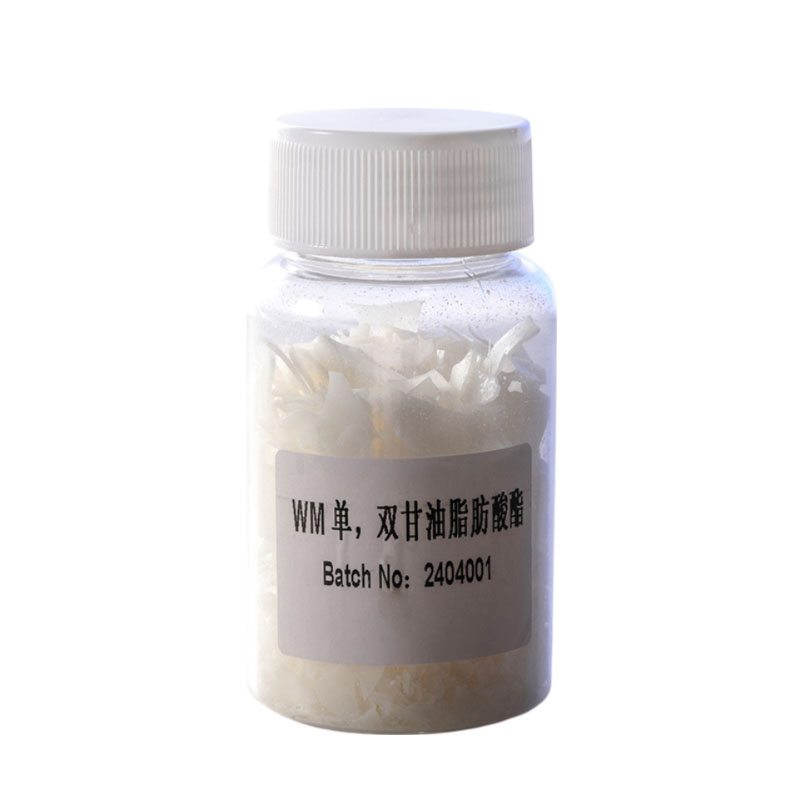In baked goods, how does monoglyceride delay staling and extend the shelf life of products like bread?
Release Time : 2025-10-27
In the modern baking industry, maintaining the fresh taste and soft texture of bread, cakes, and pastries is a core challenge. Freshly baked bread is soft and sweet, but often begins to "stall" within a few hours or a day or two, becoming hard, dry, and losing elasticity. This "stall" phenomenon seriously affects its quality and shelf life. This process, known in food science as "starch retrogradation," is the primary cause of the shortened shelf life of baked goods. Monoglyceride, a food-grade emulsifier, is a key additive to address this challenge. By specifically interacting with starch molecules, it effectively delays the staling process and significantly extends the shelf life of baked goods.
1. Starch Retrogradation: The Root Cause of Bread Hardening
The main structure of bread consists of a network of gluten wrapped around a large number of gelatinized starch granules. During baking, the starch absorbs water, expands, and gelatinizes, forming a soft, elastic gel structure. However, during cooling and storage, gelatinized starch molecules gradually rearrange, forming ordered crystalline regions through hydrogen bonding. This process is known as "starch retrogradation" or "aging." As aging progresses, water is locked within the crystalline structure, preventing it from moving freely. This results in a hard, rough texture, and a loss of flavor. Amylopectin retrogrades more slowly, but still affects the overall texture stability of the product.
2. Molecular Mechanism of Monoglyceride: Forming a Complex with Starch
Monoglyceride is a nonionic emulsifier whose molecular structure consists of a hydrophilic glycerol group and a hydrophobic long-chain fatty acid. This amphiphilic structure allows it to insert into the helical structure of gelatinized starch, particularly within the cavities of amylose, forming a stable starch-monoglyceride complex. This complex prevents direct contact and orderly arrangement between amylose molecules, effectively inhibiting recrystallization and ultimately slowing starch retrogradation.
3. Improve Dough Structure and Enhance Water-Bonding Capacity
In addition to its direct effect on starch, monoglyceride also plays a positive role during the dough mixing stage. It interacts with gluten proteins, enhancing the elasticity and extensibility of the gluten network, making the dough more gas-holding, and helping to effectively retain carbon dioxide during fermentation, thereby improving the specific volume and texture of the bread. Furthermore, the addition of emulsifiers improves the dispersion of oil in the dough, distributing the fat evenly in the form of tiny droplets, further enhancing the dough's water-binding and water-retention capacity. This means that even during long-term storage, the bread maintains a high moisture content, reducing the feeling of dryness and hardness.
4. Synergistic Effects and Wide Applications
In actual production, monoglyceride is often used in combination with other emulsifiers to achieve synergistic effects. For example, DATG primarily strengthens gluten, while monoglyceride focuses on anti-staling properties. The combination of the two can comprehensively improve bread quality. Monoglyceride is also widely used in cakes, steamed buns, and frozen pastries. In cakes, it prevents moisture loss and maintains a moist texture. In frozen foods, it mitigates the damage to starch structure caused by freeze-thaw cycles, maintaining a stable texture after thawing.
As an anti-aging agent in baked goods, monoglyceride, with its unique molecular structure and ability to form complexes with starch, effectively addresses key issues such as bread hardening and texture degradation without changing the production process. It is not only a technical means to improve product quality but also a key driver in driving the baking industry to achieve long shelf life, high added value, and sustainable development.
1. Starch Retrogradation: The Root Cause of Bread Hardening
The main structure of bread consists of a network of gluten wrapped around a large number of gelatinized starch granules. During baking, the starch absorbs water, expands, and gelatinizes, forming a soft, elastic gel structure. However, during cooling and storage, gelatinized starch molecules gradually rearrange, forming ordered crystalline regions through hydrogen bonding. This process is known as "starch retrogradation" or "aging." As aging progresses, water is locked within the crystalline structure, preventing it from moving freely. This results in a hard, rough texture, and a loss of flavor. Amylopectin retrogrades more slowly, but still affects the overall texture stability of the product.
2. Molecular Mechanism of Monoglyceride: Forming a Complex with Starch
Monoglyceride is a nonionic emulsifier whose molecular structure consists of a hydrophilic glycerol group and a hydrophobic long-chain fatty acid. This amphiphilic structure allows it to insert into the helical structure of gelatinized starch, particularly within the cavities of amylose, forming a stable starch-monoglyceride complex. This complex prevents direct contact and orderly arrangement between amylose molecules, effectively inhibiting recrystallization and ultimately slowing starch retrogradation.
3. Improve Dough Structure and Enhance Water-Bonding Capacity
In addition to its direct effect on starch, monoglyceride also plays a positive role during the dough mixing stage. It interacts with gluten proteins, enhancing the elasticity and extensibility of the gluten network, making the dough more gas-holding, and helping to effectively retain carbon dioxide during fermentation, thereby improving the specific volume and texture of the bread. Furthermore, the addition of emulsifiers improves the dispersion of oil in the dough, distributing the fat evenly in the form of tiny droplets, further enhancing the dough's water-binding and water-retention capacity. This means that even during long-term storage, the bread maintains a high moisture content, reducing the feeling of dryness and hardness.
4. Synergistic Effects and Wide Applications
In actual production, monoglyceride is often used in combination with other emulsifiers to achieve synergistic effects. For example, DATG primarily strengthens gluten, while monoglyceride focuses on anti-staling properties. The combination of the two can comprehensively improve bread quality. Monoglyceride is also widely used in cakes, steamed buns, and frozen pastries. In cakes, it prevents moisture loss and maintains a moist texture. In frozen foods, it mitigates the damage to starch structure caused by freeze-thaw cycles, maintaining a stable texture after thawing.
As an anti-aging agent in baked goods, monoglyceride, with its unique molecular structure and ability to form complexes with starch, effectively addresses key issues such as bread hardening and texture degradation without changing the production process. It is not only a technical means to improve product quality but also a key driver in driving the baking industry to achieve long shelf life, high added value, and sustainable development.









